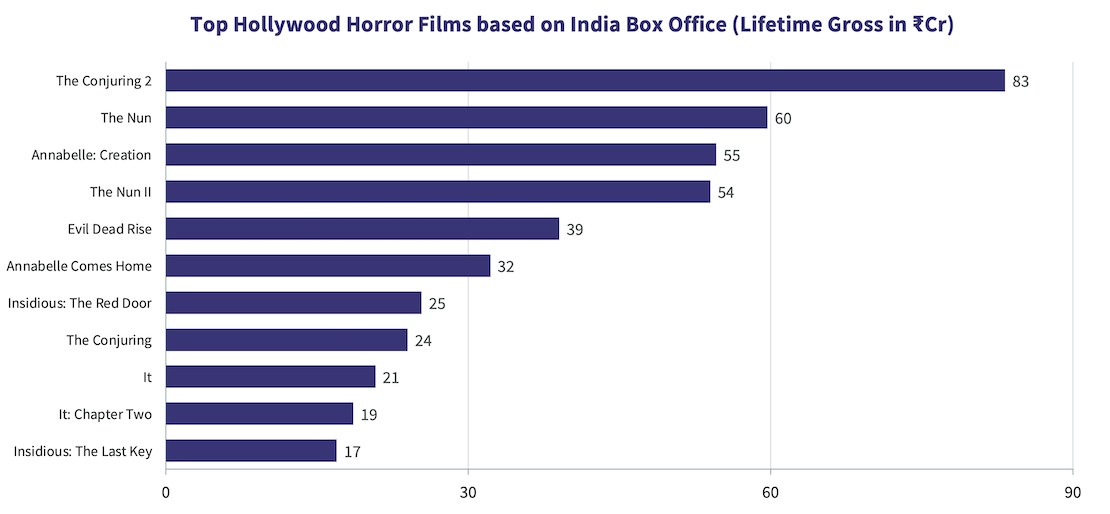


In the realm of cinema, horror stands out as one of the most distinctive and well-defined genres. Yet, the production of horror films in the otherwise-thriving Hindi film industry appears to be dwindling each year. In 2023, a record-breaking year for the Hindi box office (see our annual box office report here), only three Hindi language horror films were released, compared to the eight from Hollywood during the same period. This makes horror one of the few genres (superhero being the other one) where Hollywood has stronger presence in India than Hindi cinema. Why is Hindi cinema averse to this genre? Is it back of a lack of audience interest? Let’s take a deeper look.
A glance at the box office of Hollywood horror films in India paints a promising picture for the genre. The Conjuring 2 (2016) grossed ₹83 Cr, and is the highest-grossing Hollywood horror film in India till date (see chart below). The Nun II (2023) grossed ₹54 Cr, despite its clash with Jawan, the highest-grossing film of that year. The Conjuring franchise alone has amassed more than ₹300 Cr in India across its eight films. Surely, there’s an audience available.
 The scarcity of horror films wasn't always the norm in the Hindi film industry. The industry once had a vibrant pulp horror genre spearheaded by the Ramsay brothers, who churned out about 30 horror films between the 1970s and 2000s. Post this wave, instances of Hindi horror film releases have been few and far in between. Raaz (2002), Darna Mana Hai (2003), Bhoot (2003), Kaal (2005), 1920 (2008), and 13B (2009) were some of the better-marketed horror films in the decade of 2000-2009. Since 2010, Tumbbad stands out as the only non-franchise Hindi horror film to have received some audience appreciation, with an Ormax Power Rating (a measure of audience likeability) of 64. Though niche, with a lifetime box office of only ₹16 Cr gross, it is the only Hindi horror film to have crossed the 60-mark, a level many Hollywood horror films have managed to surpass.
The scarcity of horror films wasn't always the norm in the Hindi film industry. The industry once had a vibrant pulp horror genre spearheaded by the Ramsay brothers, who churned out about 30 horror films between the 1970s and 2000s. Post this wave, instances of Hindi horror film releases have been few and far in between. Raaz (2002), Darna Mana Hai (2003), Bhoot (2003), Kaal (2005), 1920 (2008), and 13B (2009) were some of the better-marketed horror films in the decade of 2000-2009. Since 2010, Tumbbad stands out as the only non-franchise Hindi horror film to have received some audience appreciation, with an Ormax Power Rating (a measure of audience likeability) of 64. Though niche, with a lifetime box office of only ₹16 Cr gross, it is the only Hindi horror film to have crossed the 60-mark, a level many Hollywood horror films have managed to surpass.
Interestingly, the horror genre also witnessed an occasional thrust in Hindi, through the hybrid genre of Horror Comedy, with films like Bhool Bhulaiyaa (2007), Golmaal Again (2017), Stree (2018), and Bhool Bhulaiyaa 2 (2022) being immensely successful, being one of the top films of their respective years, and also scoring in the 60s and the 70s on Ormax Power Rating. But when it comes to classical horror genre, Hindi cinema has not managed to make a mark.
The Hindi film industry's perception of horror as merely an ROI (return-on-investment) genre may have stifled innovation in this space, and limited the genre's growth potential, even as other genres like action, drama, comedy, and romance continue to reinvent to suit the changing audience needs.
A key barrier regarding the audience acceptance of Hindi horror films is the disparity in visual effects and animation quality, compared to Hollywood films. It is not unusual for audiences to make fun of graphics in Hindi horror films, using terms like powder wala bhoot or comedy bhoot in focus groups. It could be argued that Hindi cinema does not have the budgets of Hollywood to match the quality of special effects in those films. But this is a facetious argument, because unlike superhero films, we are not talking of astronomical budgets here. And there are several benefits that Hindi horror films can uniquely offer, which will make them stand apart from Hollywood films, or from Hindi films in other mainstream genres. Let’s look at four such benefits:
1. Limited dependence on starcast
An inherent advantage of the horror genre is its minimal reliance on star power. Even on an international scale, horror films have flourished without the need for A-list celebrities headlining these projects. While having a star may enhance appeal, it's the unique features of the genre that truly set it apart. Most successful horror films, spanning various industries, have succeeded without the backing of notable stars, a distinction few other genres can claim. In Hindi cinema, starcast fee is often the most significant component in the production budget, and a genre that does not rely on cast can instantly be more profitable, both in absolute and percentage terms.
2. Franchise potential
In 2019, franchise films accounted for only 17% of the domestic box office of Hindi films. But this share has surged to 45% by 2023 (read more here). Mirroring trends in Hollywood, the strategic expansion of franchises is increasingly becoming a driving force in the Indian film industry too. Therefore, narratives with franchise potential hold significant importance in ensuring robust box office growth. Horror films, with their emphasis on world-building, are particularly well-suited for franchise development, as is evident in Hollywood franchises like The Conjuring, Evil Dead, It, and Insidious. In Hindi, Raaz and 1920 franchises have scratched the surface. But the origin of these franchises dates back to 2002 and 2008 respectively, and their syntax does not account for the taste of the modern Indian audiences.
3. A fitting theatrical experience
The pandemic, along with surge in content consumption on OTT, has redefined audience expectations from theatrical films. Genres such as action, adventure, and historical dramas naturally lend themselves to the immersive experience a movie theatre uniquely offers, compared to at-home consumption. Likewise, horror films, with their ability to evoke fear, make a compelling case for communal viewing on the big screen. Also, they rely on immersive visuals and sound effects, which are best experienced on the big screen. Horror is poorly indexed on its appeal for streaming consumption vis-a-vis theatrical consumption for this reason.
4. Scope for telling rooted horror stories
Indian culture is rich in mythology and folklores, with hundreds of tales of demons, asuras, djinns, black magic, the works. This rich cultural tapestry presents a unique opportunity to craft horror narratives that resonate with the audiences between the visuals and the sound. The success of films and web-series like Bahubali, Kantara, and Asur offers an insight into the potential of mythology and folklore towards creating engaging content that’s relatable to the mass audience.

In the post-pandemic era, where the demand for differentiated theatrical experiences is paramount, the revival of the horror genre presents a compelling opportunity for Hindi filmmakers. By tapping into audience expectations, leveraging cultural narratives, and embracing innovative storytelling, filmmakers have the chance to redefine the horror landscape, and captivate audiences anew. This week’s release Shaitaan can be a step forward in this direction.

Ormax Cinematix's FBO: Accuracy update (November 2025)
This edition of our monthly blog summarises Ormax Cinematix's box office forecasts (FBO) for all major November 2025 releases vis-à-vis their actual box-office openings

Product update: Content testing for the horror genre
Based on our accumulated audience insights, we are introducing genre-specific drivers for horror films and series in our content testing tools, Ormax Moviescope and Ormax Stream Test

The India Box Office Report: October 2025
Driven by Kantara - A Legend: Chapter-1, October 2025 has emerged as the highest-grossing box office month of the year at the India box office, with gross collections of ₹1,669 Cr
Subscribe to stay updated with our latest insights
We use cookies to improve your experience on this site. To find out more, read our Privacy Policy